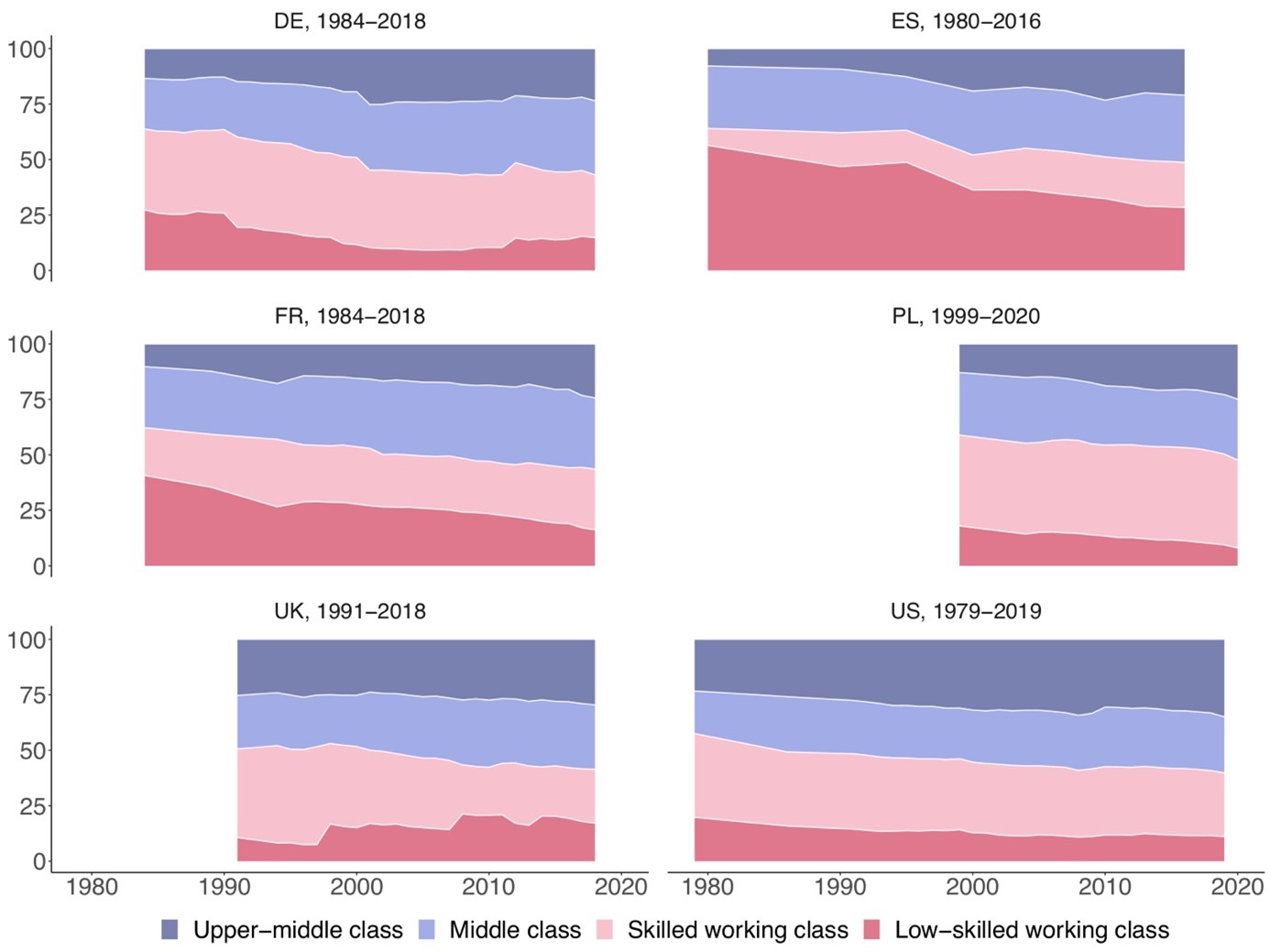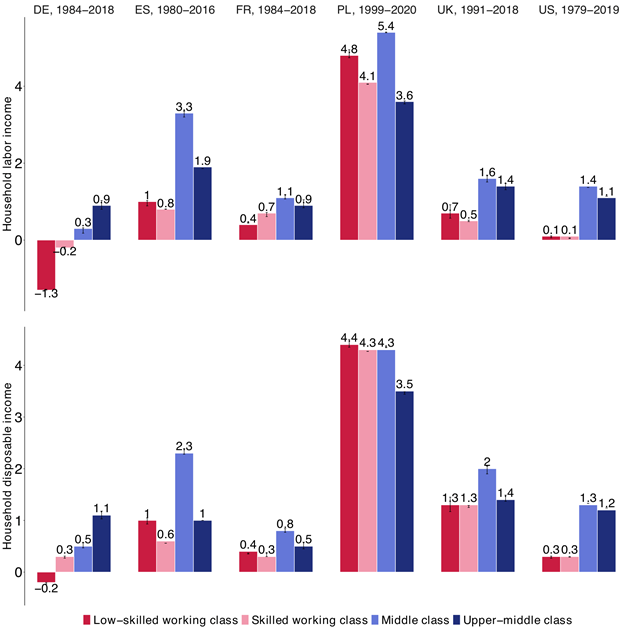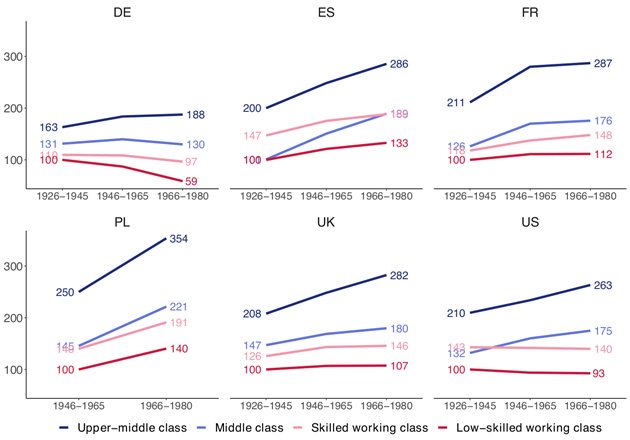
Issue, No.26 (June 2023)
The Myth of the Middle Class Squeeze: Employment and Income by Class in Six Western Countries, 1980-2020 *
Over the last two decades, income inequality has moved to the top of the research agenda in sociology (McCall and Percheski 2010) and economics (e.g. Atkinson 2015). In contrast, less attention has been devoted to the question of how absolute incomes have evolved over time (Nolan 2018). Yet while individuals only have a very vague idea of income inequality (Engelhardt and Wagener 2018), they are keenly aware of how their absolute income evolves year by year.
Since the 1980s, growth in median incomes has slowed down across the Western world, stagnating over long periods in Germany, France or the US (Nolan 2020). Income stagnation not only means that productivity growth is not shared equally, but also translates into stalled living standards for successive cohorts. In the public debate, income stagnation has been linked with middle class squeeze. Across the Western world, a common narrative considers the middle class as the primary victim of the new gilded age – both in terms of falling employment (Autor and Dorn 2013) and eroding incomes (Grabka and Frick 2009). Primarily proposed by economists, this narrative has found a large echo in the mass media.1
The corrosive effect of stagnating incomes on households is undisputed. However, we challenge the thesis of a middle class squeeze and argue instead that the great loser of the last four decades was not the middle class, but the people laboring below them, the working class. Our goal is to show empirically how different social classes fared between 1980 and 2020. We trace the evolution of employment and income by class in six large Western countries – France, Germany, Poland, Spain, the United Kingdom and the United States.
Our analysis is based on the best available comparative micro-database, the Luxembourg Income Study (LIS) Database, which allows combining several dozen country surveys such as the Current Population Survey for the US or the Socio-Economic Panel for Germany. We focus on the household level as the decisive unit of people’s well-being and show how the working-age population fared over the last decades in terms of household labor income and household disposable income.
Change in employment
Before analyzing the evolution in income, we need to document that labor demand has been biased against the working class. For this reason, Figure 1 shows how the class composition of the economically active population aged 25 to 60 evolved over the last four decades. In the 1980s and early 1990s, the two working classes jointly outnumbered the two middle classes in all six countries. With over a third of the labor force, the skilled working class was initially the largest single class in Germany (37% in 1984), Poland (41% in 1999), the UK (40% in 1991) and the US (38% in 1979), whereas the low-skilled working class was numerically predominant in France (41% in 1984) and Spain (56% in 1980).
Three to four decades later, the class composition looks very different as the middle class and upper-middle class jointly outnumber the skilled and unskilled working class in every one of the six countries. While the upper-middle class has become the most sizeable single class in the UK (30%) and the US (35%) at the end of the 2010s, it is the middle class that predominates in Germany (33%), France (32%) and Spain (30%). Only in Poland the skilled working class has remained the largest class category with 40 percent of the workforce in 2020.
These findings do not seem to be driven by differential selection into employment over time either. For the five countries under study which we observe for three decades and more (all except Poland), the share of households headed by an adult aged 25 to 60 where no member was in paid employment – because of unemployment or economic inactivity – decreased over time: from 31% in the 1980s to 28% in the 1990s and 24% in the 2000s and 2010s.
Figure 1: The class composition of the workforce over time (in %)

Change in labour income
We examine the class-income nexus in greater detail with a multivariate model that accounts for age, gender and household size. The upper panel of Figure 2 shows the adjusted predictions of these models (also known as marginal effects), expressed on an annualized basis, and compares household labor income with household disposable income. These results lead to very similar conclusions. We observe that Poland is the only country where working-class households obtained comparable gains in labor income as did middle-class households. Poland’s broadly shared income growth contrasts with the situation in the US, Spain and, above all, Germany where the middle and upper-middle class earned, on average, one percent more per year over the last three decades as compared to the low-skilled working class. Summed up over thirty years, this led to a widening of the labor income gap by 33 percent.
If the focus is shifted to household disposable income rather than household labor income, conclusions remain almost unchanged (Figure 2, lower panel). Thanks to the redistributive character of taxes and transfers, the low-skilled and skilled working class fared a bit better in Germany and the UK in terms of disposable income rather than labor income. Germany’s low-skilled working class lost one percentage point less of disposable income than labor income – but still had to contend with negative growth in disposable income between 1984 and 2018. Similarly, in the UK, the income trajectories become more similar across classes if we compare disposable rather than labor household income.
Figure 2: Annual change in household labor income and household disposable income, in %

Note: Results are based on a regression on the log of household income with controls for class, age, gender and household size. We use the income predicted by the regression for a given class at the beginning and end of each period in order to calculate the difference. This difference is then divided by the number of intervening years.
Differences across birth cohorts
The question arises of how the income evolution of classes varied across birth cohorts. Figure 3 provides an answer by showing the predicted household labor income by class for three cohorts. These analyses control for age (in single years), gender and household size and are restricted to individuals aged 35 to 50. For easier interpretation, we set the income at 100 for the low-skilled working class born into the Silent Generation (1926-45) and express all other incomes relative to this reference value.
When comparing the experience of different working-class cohorts, three income trajectories can be distinguished. First, a downward trajectory describes the German experience where working-class incomes at a given age were highest in the Silent Generation, stagnated for workers belonging to the Baby Boomers (1946-65) and declined for workers in Generation X (1966-1980). In Germany’s low-skilled working class, each successive generation had to settle for lower incomes than the Silent Generation whose early working lives coincided with the Wirtschaftswunder – economic miracle – of the post-war decades.
Second, a stagnant trajectory applies to the working-class experience of the three birth cohorts in the United States. In clear contrast to the American middle and upper-middle class, the working class born in the Baby Boomer and Generation X cohorts made no income gains compared to their working-class parents and grandparents. In the US, as in Germany, the living standards of the working class had stalled for successive birth cohorts.
Third, an upward trajectory in a weak version, applies to France and the UK where ensuing working-class cohorts did slightly better than the working class in the Silent Generation. However, income gains were meager and remained below the increases observed for the same birth cohorts in the middle and upper-middle class. A clear upward trajectory can only be observed for Poland and Spain. In Spain, working-class households of Generation X earned inflation-corrected labor incomes that exceeded those of working-class households in the Silent Generation by almost 50 percent. Similarly, in Poland where our data cover a shorter time span, the working-class incomes of Generation X surpassed those of the Baby Boomer working class by 50 percent.
If the focus is shifted to the middle and upper-middle class, country differences shrink. The incomes of the middle and upper-middle class barely grew across birth cohorts in Germany. In France, the US and the UK, households of the middle and upper-middle class saw their incomes grow slowly, but they fared clearly better in the Baby Boomer cohort than in the Silent Generation and, with the notable exception of France, somewhat better in Generation X than among Baby Boomers. Again, we observe the strongest income gains of the upper-middle and middle class across birth cohorts in Spain and, over just one generation, in Poland.
Figure 3: Household labor income by class and cohort (adjusted predictions)

Note: Results are based on a linear regression on the log of household income with controls for class, cohort, class*cohort, age, gender and household size. They show the adjusted predictions for the cohort term and interaction term between class and cohort. All incomes are expressed relative to the income of the low-skilled working class in the Silent Generation which is set, within each country, at 100.
Discussion
In their recent forays into class analysis, prominent economists argued that the middle class was declining (Pressman 2007), eroding (Vaughan-Whitehead 2020) and had been wrecked by technology. The dominant thesis was that technology “led the middle class to experience a hollowing out in terms of wages and employment” (Jaimovich 2020: 4). Our analysis rejects this thesis on the basis of three main findings.
The middle class experienced gains in both employment and income. There has been no middle class squeeze over the last decades, neither in terms of employment nor income. In the 1980s and early 1990s, the middle and upper-middle class were still outnumbered by the skilled and low-skilled working class in the six large Western countries that we studied. Yet over the last four decades, the relative sizes shifted as job opportunities expanded for managers, professionals and technicians, while they declined for laborers, assemblers, craft workers and clerks. Consistent with a host of recent comparative studies (Fernandez-Macias & Hurley 2017, Oesch and Piccitto 2019), we observe the upgrading of the class structure in all countries except the UK where the class structure polarized, with employment growth in the upper-middle and middle class as well as in the low-skilled working class.
Over the last three to four decades, there was no income squeeze of the middle class either as household labor income of the middle and upper-middle class increased, on average, by about one percent per year in France, the UK and the US. This may appear modest when compared to the post-war decades, but corresponds nonetheless to an income increase of 33 percent over thirty years. The income trajectory of middle and upper-middle class households was steeper in Spain with annual increases of 2 to 3 percent and in Poland with 3 to 4 percent, but flatter in Germany with less than one percent. Over the last decades, the promise of doing economically better than one’s parents and grandparents still held for the members of the middle and upper-middle class in France, Poland, Spain, the UK and the US. The only exception is Germany where living standards stagnated for successive middle-class cohorts.
The working class lost out: Both in terms of employment and income, the great loser over the last decades was the working class. In the wake of skill-biased technological change, globalization and the neoliberal turn in politics, labor market opportunities deteriorated for the working class. The employment share of the low-skilled working class fell massively in both the large and small countries we studied, the UK being the sole exception. The skilled working class also shrank in most countries, albeit less strongly. As a result, in the 21st century, the working class lost its majority status that it had held in Europa and the US over most of the 20th century.
Implications of the working-class decline: Our analysis’ main findings is the extraordinary decline that the working class experienced over the last decades, both in terms of employment and income. In our view, much of the recent political turmoil in Western democracies is due to the working class losing out. As neither markets nor politics delivered any real improvement in living standards over the last decades, growing shares of the working class turned towards candidates and parties of the radical right. In the context of insecure jobs and stagnant incomes, these parties’ vociferous resistance to globalization, multiculturalism and national elites struck a chord with the discontented working-class electorate (Bornschier and Kriesi 2012).
Given the empirical evidence, we see only one way in how the thesis of a middle class squeeze could be rescued: by arguing that there is no such a thing as the working class because the middle class begins when poverty ends (Ravallion 2010). This semantic argument has gained substantial traction among economists and international organizations such as the OECD. Yet it is so clearly inconsistent with the recent history of industrial societies that it requires a healthy measure of amnesia. Between 1945 and 2020, 34 articles mentioned the working class in the title of the American Sociological Review and 76 articles in the American Journal of Sociology. This is a lot of attention for a non-existent class.
A final question remains: Why did the narrative of a middle class squeeze gain so much public prominence despite the lack of evidence? Besides the argument that the middle class has replaced the working class in the language of the 21st century, two additional arguments focus on morals and expectations. According to a moral argument, the stagnation of working-class incomes may not have been overly worrisome to many pundits, as it only seemed natural that in the knowledge economy workers without higher education would see their incomes stall. The perception of the problem changed, however, once white-collar employees with post-secondary educational degrees experienced a slowdown of income growth. For the educated middle-class, the halted economic elevator appeared altogether undeserved and was seen as “a broken promise”.
Finally, the thesis of the middle class squeeze may also be linked to people’s expectations of income growth. Three decades of massive GDP growth after 1945 led to firmly entrenched expectations of rising incomes and living standards. Workers socialized in this context came to view annual income gains of half to one percent as a step back (Inglehart and Norris 2017). Moreover, the slowdown in economic growth did not only mean that there was less income to distribute – but, crucially, this income was distributed unequally as a small elite class pocketed the lion’s share in the new gilded age (Piketty 2014).
The statement that the middle class has been left behind is therefore correct when compared with the fortune of those above. However, it completely ignores that the real losers of the last few decades were situated below – the working class.
* This article is an outcome of a research visit carried out in the context of the (LIS)2ER initiative which received funding from the Luxembourg Ministry of Higher Education and Research.
1 For the US: New York Times, “What’s really squeezing the middle class?”, April 25 2007. Financial Times, “The crisis of middle class America”, July 30 2010. Wall Street Journal, “The middle class squeeze”, September 25 2015. For the UK: Guardian, “Robots will not lead to fewer jobs – but the hollowing out of the middle class”, August 20 2017. For Germany: Spiegel, “Deutschlands Mittelschicht schrumpft dramatisch“ [Germany’s middle class shrinks dramatically], December 13 2012. Süddeutsche Zeitung, „Schrumpfende Mittelschicht: arbeite hart, aber besser geht es dir nicht“ [Shrinking middle class: work hard, but you won’t fare any better], August 29 2015. For Spain: El Diario “Adiós a la clase media” [Farewell to the middle class], December 18 2014. El País: “La Clase media menguante” [The declining middle class], September 29 2019.
References
| Atkinson, A. B. (2015). Inequality: What Can Be Done? Cambridge, Massachusetts: Harvard University Press. |
| Autor, D. H., and Dorn, D. (2013). “The Growth of Low-Skill Service Jobs and the Polarization of the US Labor Market.” American Economic Review 103(5):1553–97. doi: 10.1257/aer.103.5.1553. |
| Bornschier, S., and Kriesi, H. P. (2012). “The Populist Right, the Working Class, and the Changing Face of Class Politics.” Pp. 28–48 in Class Politics and the Radical Right, edited by J. Rydgren. New York: Routledge. |
| Engelhardt, C., and Wagener, A. (2018). “What Do Germans Think and Know about Income Inequality? A Survey Experiment.” Socio-Economic Review 16(4):743–67. doi: 10.1093/ser/mwx036. |
| Fernández-Macías, E., and Hurley, J. (2016). “Routine-Biased Technical Change and Job Polarization in Europe.” Socio-Economic Review mww016. doi: 10.1093/ser/mww016. |
| Grabka, M. M., and Frick, J. R. (2009). The Shrinking German Middle Class: Signs of Long-Term Polarization in Disposable Income? 4 (4). DIW Berlin Weekly Report. |
| Jaimovich, N. (2020). Disappearing Middle Class: Job Polarization and Policy Approaches. 8. UBS Center Public Paper Series. |
| McCall, L., and Percheski, C. (2010). “Income Inequality: New Trends and Research Directions.” Annual Review of Sociology 36(1):329–47. doi: 10.1146/annurev.soc.012809.102541. |
| Nolan, B. (2018). Inequality and Inclusive Growth in Rich Countries: Shared Challenges and Contrasting Fortunes. Oxford: Oxford University Press. |
| Nolan, B. (2020). “The Median Versus Inequality-Adjusted GNI as Core Indicator of ‘Ordinary’ Household Living Standards in Rich Countries.” Social Indicators Research 150(2):569–85. doi: 10.1007/s11205-020-02311-0. |
| Oesch, D., and Piccitto, G. (2019). “The Polarization Myth: Occupational Upgrading in Germany, Spain, Sweden, and the UK, 1992–2015.” Work and Occupations 46(4):441–69. doi: 10.1177/0730888419860880. |
| Piketty, T. (2014). Capital in the Twenty-First Century. Harvard University Press. |
| Pressman, S. (2007). “The Decline of the Middle Class: An International Perspective.” Journal of Economic Issues 41(1):181–200. doi: 10.1080/00213624.2007.11507000. |
| Ravallion, M. (2010). “The Developing World’s Bulging (but Vulnerable) Middle Class.” World Development 38(4):445–54. doi: 10.1016/j.worlddev.2009.11.007. |
| Vaughan-Whitehead, D. (2020). “European Middle Class under Threat.” in The middle class in world society: negotiations, diversities and lived experiences, edited by C. Suter, S. Madheswaran, and B. P. Vani. New York: Routledge. |
